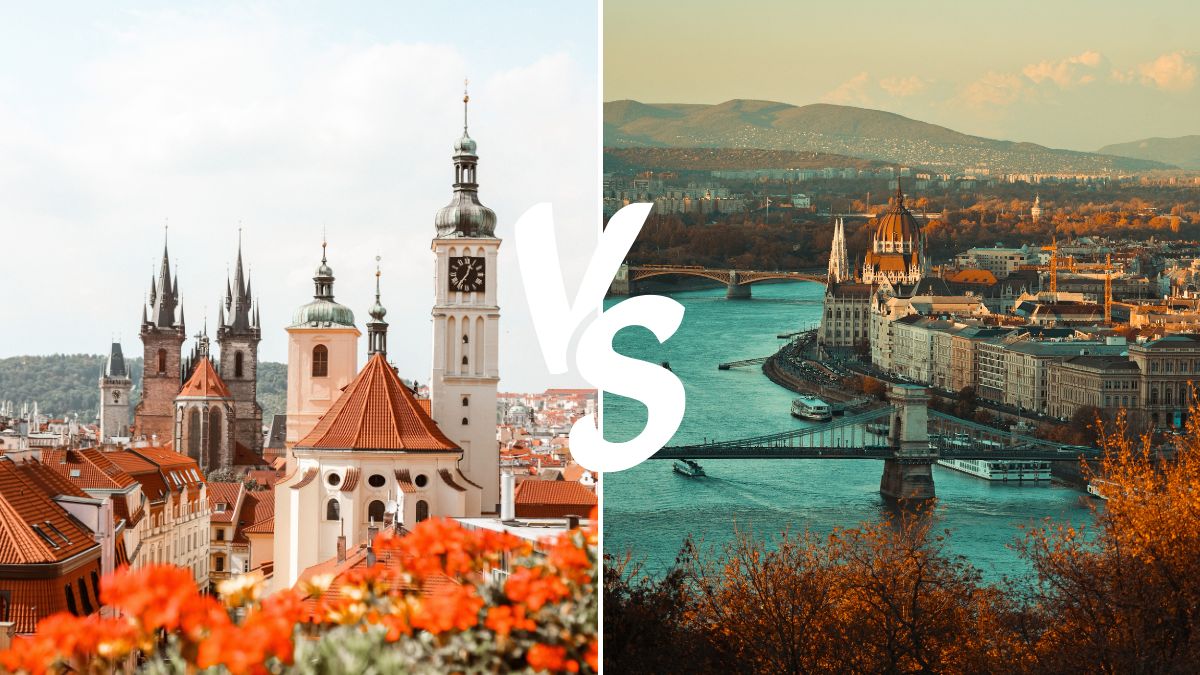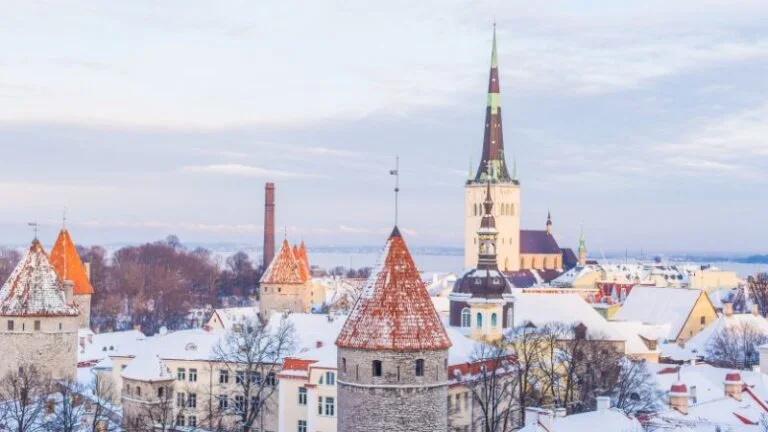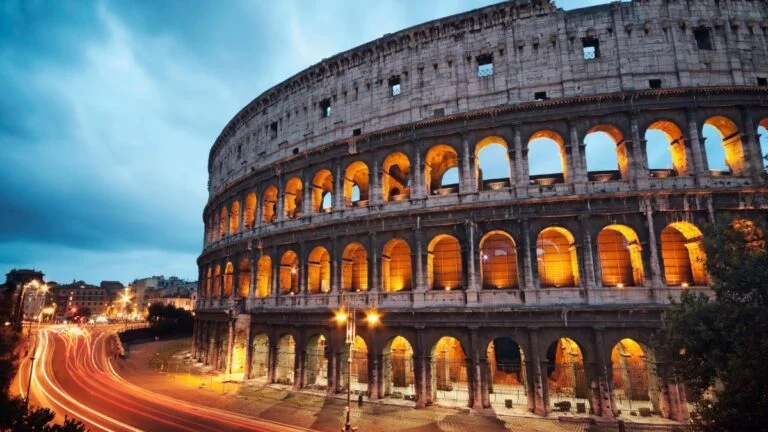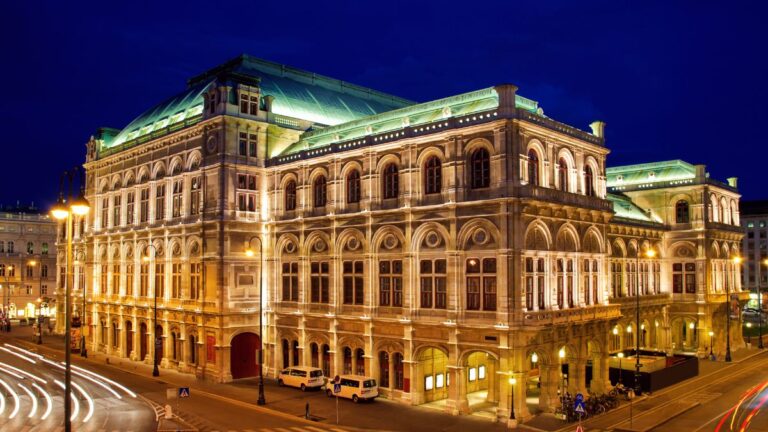Budapest Vs. Prague: Comparing Two Alluring European Destinations

As participants in Amazon Associates and other programs, we earn from qualifying purchases. This comes at no additional cost to you. For more details, see our Affiliate Disclosure.
In the charming heart of Central Europe, two timeless cities – Budapest and Prague – have enthralled travelers for centuries. Each radiates its own distinct character and allure, vying for attention with a rich tapestry of history, culture, cuisine, and architectural splendor. Budapest, the “Pearl of the Danube,” offers a seductive blend of East and West, where Turkish baths coexist with Austro-Hungarian palaces. Meanwhile, Prague, the “City of a Hundred Spires,” charms with its fairy-tale-like ambiance and Bohemian allure. The dilemma then presents itself: Budapest or Prague? Which of these mesmerizing cities should you visit first or choose as your ultimate destination?
This article attempts to put that debate to rest by dissecting and comparing various facets of these two captivating European capitals. Buckle up as we embark on an enchanting journey between Budapest and Prague.
Historical Background: Budapest vs Prague
Delving into the past of both Budapest and Prague provides insight into their present charm and character. Their histories are as complex and riveting as the cities themselves, filled with epochs of glory, periods of struggle, and times of rebirth.
Budapest: The Danube’s Pearl
The history of Budapest is a fascinating saga of amalgamation and resilience. The city as we know it today is a union of three distinct towns – Buda, Pest, and Óbuda, unified in 1873. Its roots, however, go back to the ancient Roman town of Aquincum in AD 106. But it was during the Austro-Hungarian Empire (1867-1918) that Budapest truly flourished, with architectural marvels and infrastructural developments adorning the cityscape.
The two World Wars and the 1956 Uprising left significant scars on the city, but Budapest, rising from the ashes, became a symbol of endurance. Today, it stands as a beautiful blend of the old and new, with its history echoing in the intricate Art Nouveau facades, the iconic Chain Bridge, and thermal baths, reminiscent of the Ottoman era.
Prague: The City of a Hundred Spires
Prague’s history is a compelling narrative of arts, architecture, and power. Known to have been settled as early as the Paleolithic Age, Prague was once the seat of two Holy Roman Emperors and played a pivotal role in the Protestant Reformation and Thirty Years’ War. It served as the capital of the Kingdom of Bohemia, the main residence of several Holy Roman Emperors, and an important city to the Habsburg Monarchy and its Austro-Hungarian Empire.
The city bore witness to both the joys of burgeoning intellectual and artistic movements and the sorrows of war and totalitarian regimes. Much like Budapest, Prague too has borne the brunt of history, particularly during the Nazi occupation and the Communist era following World War II. Despite this, the city has preserved its unique character. This rich history is reflected in the Old Town Square, Prague Castle, the mesmerizing Astronomical Clock, and the atmospheric Jewish Quarter.
Comparing the historical backgrounds of both cities, Budapest and Prague exhibit tales of unity, resilience, and resurgence, each painting a vivid picture of Central Europe’s riveting past. This history is palpably etched into their streets and structures, offering a profound experience that continues to captivate travelers worldwide.
Architectural Splendor: Contrasting Styles of Budapest and Prague
The architectural narratives of Budapest and Prague are a testament to their rich historical and cultural influences. Each city unfolds a distinct panorama of styles and periods, presenting an enchanting journey through time.
Budapest: The Eclectic Ensemble
Budapest’s architectural panorama is a delightful mix, reflecting diverse cultural influences and historical periods. Dominated by Baroque, Neoclassical, and Art Nouveau styles, the city’s edifices narrate tales of its colorful past and changing rulers.
The Buda Castle, a grand manifestation of Baroque architecture, crowns the city. The Hungarian Parliament Building is another iconic structure, representing the pinnacle of Gothic Revival architecture with a touch of Renaissance influence. Art Nouveau sweeps through the city with masterpieces like the Gresham Palace, which is now an opulent hotel.
Budapest’s thermal baths, particularly the Széchenyi Thermal Bath and Gellért Baths, exhibit a mix of styles but predominantly reflect Turkish and Neo-Renaissance influences, respectively.
Prague: The Bohemian Splendor
Prague is often described as a vast, open-air museum of architecture, where styles from different epochs coexist harmoniously. It boasts an incredible array of Romanesque, Gothic, Renaissance, Baroque, Rococo, Art Nouveau, Cubist, and modernist architecture.
Prague Castle, the largest ancient castle globally, represents virtually every architectural style of the last millennium. The St. Vitus Cathedral, housed within the castle, is a stunning example of Gothic grandeur.
The Old Town is a mix of Renaissance and Baroque buildings, while the New Town showcases more modern and Art Nouveau structures. One cannot ignore the Dancing House’s innovative deconstructivist architecture, making Prague’s cityscape even more eclectic.
In comparing the architectural styles, Budapest leans towards grandeur with its palatial edifices, while Prague enchants with its quaint, bohemian charm and varied styles. Both cities are dream destinations for architecture lovers, offering visually striking and historically rich urban landscapes.
Gastronomic Adventures: From Goulash to Goulash
Central European cuisine, while sharing common roots, has evolved uniquely in different regions, and this is palpably evident in the culinary landscapes of Budapest and Prague. From hearty goulashes to divine pastries, the gastronomic journey in these two cities is a delight for every epicure.
Budapest: A Blend of Flavors
Hungarian cuisine, as showcased in Budapest, is rich, hearty, and deeply flavorful, drawing influences from Turkic, Germanic, and Slavic cuisines. The gastronomic identity of Budapest revolves around certain key ingredients: paprika, pork, and a variety of vegetables.
The iconic Hungarian goulash, a robust and hearty soup or stew of meat and vegetables, notably spiced with paprika, is a must-try. Other delectable dishes include Chicken Paprikash, rich and creamy, and Töltött Káposzta, a comforting dish of stuffed cabbage rolls. The strudels (rétes) with diverse fillings, ranging from sweet to savory, and Dobos torte, a traditional Hungarian sponge cake, end the meal on a sweet note.
Prague: Hearty and Wholesome
Czech cuisine, epitomized in Prague, offers a tantalizing array of dishes characterized by hearty flavors and wholesome ingredients. It is renowned for its meat dishes, often accompanied by the world-famous Czech beer.
The Czech version of goulash is thicker and meatier than its Hungarian counterpart, typically served with bread dumplings. Svíčková, marinated sirloin served with creamy sauce, and Trdelník, a traditional rolled pastry, are other local specialties. Prague also boasts a vibrant beer culture, with pilsners and lagers reigning supreme.
Although both cities share dishes like goulash, they offer distinct gastronomic experiences reflecting their unique histories and cultural influences. Whether it’s Budapest with its love for paprika and strudels or Prague with its hearty meat dishes and beer culture, culinary explorations in both cities promise to be nothing short of delightful.
Cultural Offerings: Museums, Theatres, and Music
Cultural expressions in Budapest and Prague are as vibrant and diverse as the cities themselves. With an abundance of museums, theatres, and music venues, these cities offer a fascinating peek into the Central European cultural landscape.
Budapest: Melding the Past and the Present
Budapest’s cultural offerings are a captivating blend of the historic and the contemporary. The city’s museums cater to a wide spectrum of interests. The Hungarian National Museum and the House of Terror provide historical insights, while the Museum of Fine Arts and the Hungarian National Gallery display extensive art collections. For a contemporary edge, the Ludwig Museum showcases modern and contemporary art.
Budapest is also renowned for its music scene. It’s the birthplace of world-renowned composers like Liszt and Bartók, and the legacy continues in venues like the opulent Hungarian State Opera House and the Liszt Academy of Music. The city’s thermal baths even serve as unique venues for music and cultural festivals.
Prague: A Cultural and Artistic Haven
Prague’s cultural richness is simply staggering. The city teems with museums, from the historical (National Museum, Jewish Museum) to the artistic (National Gallery, Mucha Museum). The Museum of Communism offers a unique perspective on Prague’s past, while the Kampa Museum caters to modern art enthusiasts.
Music and theatre are deeply ingrained in Prague’s cultural fabric. The city was once the home of Mozart, and his legacy continues to thrive in venues like the Estates Theatre. The National Theatre is another cultural icon, showcasing opera, ballet, and drama performances. In addition, Prague’s vibrant music scene covers a range of genres, from classical to jazz and rock.
When it comes to cultural offerings, Budapest and Prague both offer diverse and exciting experiences. Each city boasts a myriad of ways to immerse oneself in their distinctive histories, artistic endeavors, and musical landscapes. Whether through insightful museums, dynamic theatres, or soul-stirring music, both cities promise enriching cultural adventures.
The Great Outdoors: Parks and Natural Beauty in Both Cities
While both Budapest and Prague offer an abundance of historical and cultural attractions, they also feature a wealth of outdoor spaces. These offer the perfect escape from city life, allowing visitors to enjoy moments of tranquility amidst nature’s bounty.
Budapest: Embracing the Danube and Beyond
The natural beauty in Budapest is closely tied to the Danube River, offering breathtaking riverfront views. The Buda Hills provide a stunning green backdrop to the city, ideal for hiking and panoramic vistas of Budapest. One of the most popular outdoor spaces is Margaret Island, a peaceful haven with parks, a small zoo, and even thermal baths.
City Park (Városliget) is another notable outdoor destination. It’s home to the Széchenyi Thermal Baths, Vajdahunyad Castle, and the Budapest Zoo. For those seeking a bit of adventure, the caves under the Buda Hills, such as the Szemlőhegy Cave and the Pál-völgyi Cave, offer unique spelunking experiences.
Prague: Bohemian Rhapsody
Prague’s outdoors is a fascinating blend of manicured parks, undulating hills, and serene river views. Petřín Hill, with its lush greenery, mirror maze, and lookout tower offering spectacular city views, is a favorite among locals and tourists.
The Royal Garden at Prague Castle is a delightful retreat with beautiful landscaping and architectural marvels, while Letná Park offers stunning views of the city and the Vltava River. The Vltava itself offers numerous leisure activities, including river cruises and pedal boating.
For those seeking a unique experience, the Divoká Šárka nature reserve, on the city outskirts, offers rugged landscapes and natural beauty in abundance, showcasing the wilder side of Prague.
While both Budapest and Prague offer numerous cultural and historical attractions, their outdoor spaces provide equally captivating experiences. Whether it’s a tranquil escape in a city park, an adventurous hike in the hills, or a leisurely boat ride on the river, both cities offer a wealth of experiences for nature lovers and outdoor enthusiasts.
Nightlife in Budapest and Prague: Where to Party?
When the sun sets over Budapest and Prague, both cities come alive with vibrant nightlife that suits all kinds of party-goers. Whether you prefer a relaxed evening sipping local brews or an energetic night out at a club, these two European gems have plenty to offer.
Budapest: From Ruin Bars to River Cruises
Budapest’s nightlife is famed for its unique “ruin bars”. These quirky drinking venues have sprung up in abandoned buildings and courtyards throughout the city, particularly in the Jewish Quarter. The most famous of these is Szimpla Kert, known for its eclectic decor and lively atmosphere. Instant and Fogas Ház also offer a labyrinth of rooms to explore, each with a different theme and music style.
Beyond the ruin bars, you’ll find sophisticated cocktail bars, vibrant clubs, and music ranging from jazz to techno. A38, a converted Ukrainian ship anchored on the Danube, is a popular spot for concerts and club nights.
Prague: Beer Pubs, Clubs, and Jazz
Prague’s nightlife is diverse and plentiful, with something for everyone. The city is renowned worldwide for its beer, so it’s no surprise that beer pubs are a significant part of its nightlife. Notable spots include The Pub, Lokál, and U Fleků, a brewery and pub that’s been in operation since 1499.
The club scene in Prague is equally vibrant, with venues like Roxy, Karlovy lázně (the largest club in Central Europe), and Cross Club, known for its industrial steampunk decor. Jazz lovers will also feel at home here, with venues such as Jazz Dock and Reduta Jazz Club offering excellent performances.
Whether you choose Budapest with its ruin bars and river party cruises or Prague with its historic beer pubs and diverse clubs, both cities promise a nightlife that is exciting, memorable, and full of unique local flavor.
Living Costs: An Examination of Affordability
Whether you’re planning a short getaway or a lengthy sojourn, understanding the cost of living in your chosen destination is vital. Budapest and Prague, though offering rich cultural and historical experiences, differ significantly in terms of affordability.
Budapest: Value on the Danube
Budapest is often considered one of the most budget-friendly capitals in Europe, offering excellent value for money. While it has seen a gradual increase in prices over the years, it remains affordable for most travelers.
Accommodation options range from cost-effective hostels to luxury hotels, catering to varying budgets. Dining out in Budapest can also be economical, with a wide variety of affordable restaurants and street food. Public transportation, including the metro, trams, and buses, is reliable and inexpensive. Major attractions often have entry fees, but these are generally modest and there are discounts for students and seniors.
Prague: Bohemian Budget
Prague, while still cheaper than many Western European cities, is generally more expensive than Budapest. The city’s popularity as a tourist destination has driven up prices, especially in the city center.
Accommodation can be pricier than Budapest, particularly during peak tourist seasons. However, it’s still possible to find budget-friendly options, especially if booked in advance. The cost of food can vary greatly, with inexpensive eats available in local pubs and markets, while higher-end restaurants can be pricey.
Public transportation in Prague is excellent and affordable. Entry fees for tourist attractions can add up, but there are often various concessions available, and some attractions are free on certain days.
While both cities offer a wealth of experiences, Budapest tends to be the more affordable option. However, both can be enjoyed on a budget with some planning and savvy choices. As always, costs can vary depending on personal preferences and travel style.
Safety and Accessibility: Getting Around and Staying Safe
Safety and accessibility are key factors to consider when exploring a new city. Both Budapest and Prague have reliable public transportation networks and are generally safe for tourists, but as with any destination, it’s important to be aware of potential issues and local advice.
Budapest: Safe and Easy to Navigate
Budapest is a relatively safe city for tourists. Usual precautions should be taken against pickpocketing in crowded places and tourist hotspots. It’s also advised to be wary of taxi scams, so using reputable taxi companies or ride-sharing apps is recommended.
The city’s public transportation system is efficient and comprehensive, consisting of a metro system, trams, and buses. Navigating Budapest is fairly easy, with most attractions being accessible by foot or public transit. The city is also increasingly bike-friendly, with dedicated lanes and bike rental services.
Prague: Prudent in the Bohemian Capital
Prague is generally safe, but similar to Budapest, pickpocketing can be an issue, especially in crowded tourist areas. It’s advisable to stay vigilant, keep your belongings secure, and avoid poorly lit areas late at night.
Public transportation in Prague is highly efficient, with an extensive network of trams, buses, and a metro system. The city is compact and walkable, especially in the historic center. Taxis are widely available, but be sure to use reputable companies or ride-hailing apps to avoid being overcharged.
While both Budapest and Prague are generally safe and easy to get around, it’s important to stay cautious and aware of your surroundings. Always follow local advice, use common sense, and prioritize personal safety to ensure a smooth and enjoyable travel experience.
Must-visit Places: Iconic Landmarks and Hidden Gems
Budapest and Prague are both brimming with iconic landmarks and hidden treasures waiting to be discovered. Whether it’s the historical richness, architectural splendor, or local charm, these cities offer a wealth of must-visit places.
Budapest: Blend of Grandeur and Quirkiness
Budapest’s must-visit list is dominated by grand historical landmarks. The UNESCO-listed Buda Castle, iconic Chain Bridge, and the stunning Parliament Building are essential. Don’t miss the opportunity to soak in the thermal waters of Széchenyi or Gellért Baths.
However, Budapest is also home to less known treasures. The ruin bars, particularly Szimpla Kert, provide a unique Budapest experience. Explore the caves beneath the city, like Pál-völgyi Cave, or walk around the lesser-known Art Nouveau beauties like the Gellért Thermal Baths and Hotel, Museum of Applied Arts, and the Postal Savings Bank.
Prague: Historical Charms and Bohemian Whimsy
Prague’s must-visit places are steeped in history and architectural beauty. The Prague Castle complex, including the stunning St. Vitus Cathedral, and the Charles Bridge are absolute musts. The Old Town Square with its Astronomical Clock offers a charming ambiance.
Off the beaten path, the Lennon Wall is a symbol of peace and rebellion. Letná Park, aside from its lush greenery, offers a stunning panoramic view of the city. The quirky and modern Dancing House is a stark contrast to the city’s gothic and baroque architecture. Lastly, for a serene experience, take a stroll around Vyšehrad, a historic fort located a little away from the city center.
Whether you are drawn to the grandeur of iconic landmarks or the charm of hidden gems, both Budapest and Prague offer a treasure trove of sights to explore and experiences to relish.
Overall Atmosphere: The Vibe and Tempo of the Cities
When choosing between two destinations, understanding the overall atmosphere, the vibe and tempo of the cities, can be as important as comparing specific attractions or costs. Both Budapest and Prague have distinct atmospheres, shaped by their unique histories, cultures, and lifestyles.
Budapest: A Blend of Laid-Back and Lively
Budapest carries a blend of the laid-back and the lively. The city feels relaxed and unhurried, yet vibrant and dynamic. It’s a place where you can soak in thermal baths in the morning, wander around historic castles or museums in the afternoon, and enjoy buzzing ruin bars or riverside promenades by night.
The cityscape is a visual delight, with the Danube River slicing it into the hilly, historical Buda and the flat, lively Pest. The overall atmosphere is welcoming and comfortable, reflecting the warmth of Hungarian hospitality.
Prague: Enchanting and Vibrant
Prague’s atmosphere is often described as magical and enchanting, a feeling accentuated by its fairy-tale-like cityscape of cobblestone streets, charming squares, and stunning architecture from different eras. The city feels like a step back in time, especially in the historic center, yet it also has a youthful and vibrant side, thanks to a thriving cultural scene and nightlife.
Prague pulses with energy, especially in areas like Wenceslas Square and Old Town. Yet, it also offers peaceful retreats in its parks and gardens or by the tranquil Vltava River. The Czechs’ love for beer is palpable, lending a convivial atmosphere to its many beer gardens and pubs.
In summary, both Budapest and Prague offer distinct atmospheres that are equally appealing. Whether it’s the blending of the relaxed and dynamic in Budapest, or the merging of the enchanting and vibrant in Prague, both cities offer experiences that captivate and resonate with their visitors.
Seasonal Variations: The Best Time to Visit
The time of year you choose to visit a city can greatly influence your experience. Weather conditions, crowd sizes, and events are all subject to seasonal variations. Let’s explore the best times to visit Budapest and Prague.
Budapest: From Warm Summers to Festive Winters
Budapest experiences warm summers, chilly winters, and mild spring and autumn seasons. The most popular time to visit is during the summer (June to August), when the weather is ideal for sightseeing and outdoor activities. However, this period also attracts the most tourists, resulting in crowded attractions and higher prices.
Spring (April to June) and autumn (September to October) are great times to visit Budapest, with pleasant weather and fewer tourists. The city is especially beautiful in spring when the cherry blossoms are in bloom.
Winter in Budapest can be cold, but the city transforms into a festive wonderland with Christmas markets and thermal baths appearing even more inviting in the cold. If you don’t mind the chill, it’s a unique time to experience Budapest’s charm.
Prague: Balancing Weather and Crowds
Like Budapest, Prague has a warm summer, cold winter, and mild spring and autumn seasons. The city’s beauty peaks in the summer (June to August) with warm, sunny days perfect for exploring the city. However, it’s also the peak tourist season, resulting in crowded sights and higher accommodation prices.
Spring (April to June) and autumn (September to October) are considered the best times to visit Prague, offering a good balance between pleasant weather and manageable tourist crowds. Prague in autumn is particularly beautiful with colorful fall foliage adorning the city.
Winter in Prague is cold, but the city becomes a magical, snowy wonderland, especially around Christmas. The festive Christmas markets, particularly in the Old Town Square and Wenceslas Square, add a special charm to a winter visit.
Both Budapest and Prague can be enjoyed all year round, with each season offering its own unique charm and experiences. Your choice largely depends on your preferences for weather, crowd sizes, and seasonal activities.
Choosing Your Next European Destination
Deciding between Budapest and Prague is no easy task, as both cities offer their unique charm, rich history, and cultural delights. However, your choice may ultimately depend on your personal preferences and what you want from your European getaway.
Budapest: A Blend of Relaxation and Excitement
Budapest may be your ideal destination if you’re looking for a city that combines relaxation with excitement. The city’s unique thermal baths offer a spa-like experience rarely found in other capitals.
The bustling nightlife, particularly the unique ruin bars, offers a vibrant and dynamic scene for those seeking late-night adventures. Additionally, Budapest is generally more affordable, which can be a significant advantage for budget-conscious travelers.
Prague: Historical Enchantment and Bohemian Vibes
Prague might be the perfect choice if you appreciate fairy-tale like historical settings. The city’s enchanting architecture, from the expansive Prague Castle to the charming Old Town, offers a deep dive into history and culture.
Prague also boasts a robust beer culture, with traditional pubs and beer gardens offering a taste of local life. While slightly more expensive than Budapest, it’s still more affordable compared to other popular European capitals.
Whether you choose Budapest’s relaxing thermal baths and dynamic nightlife or Prague’s enchanting historical sites and robust beer culture, you’re in for a memorable travel experience. Consider your preferences and interests, and let them guide you towards your next captivating European destination.






